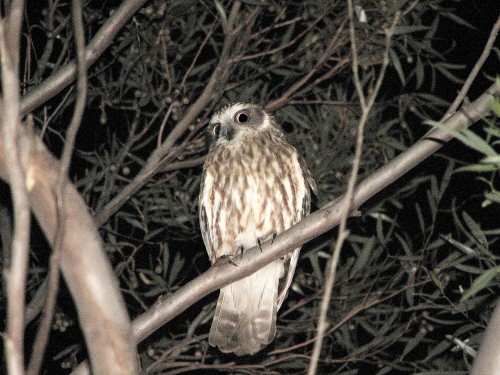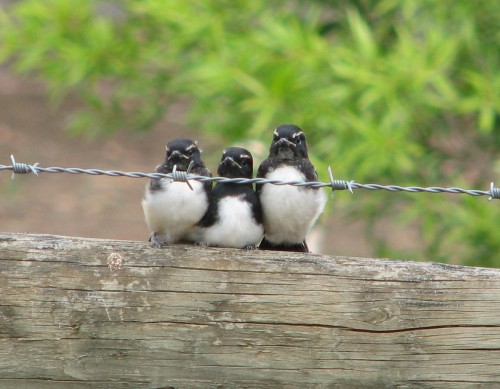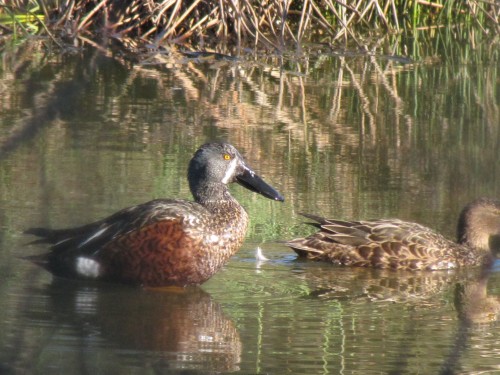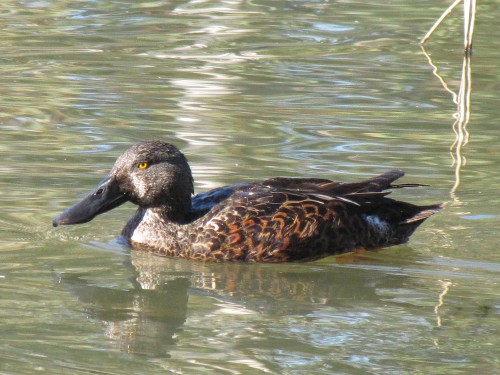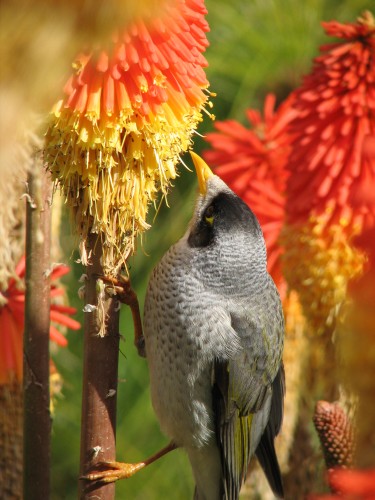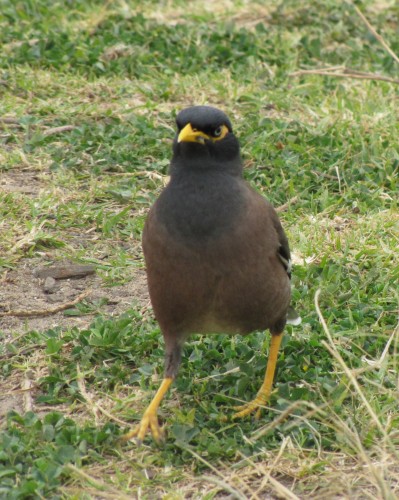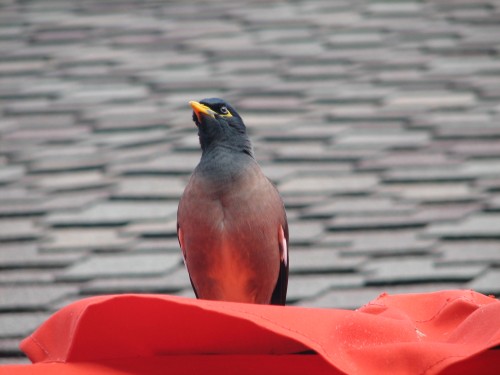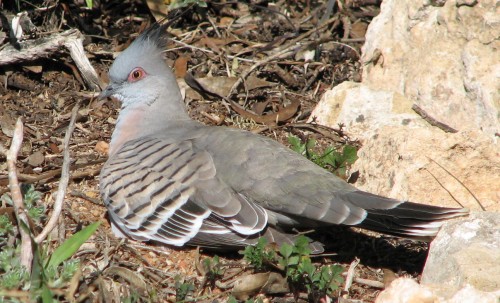A special night visitor
Last night we had a wonderful visitor to our garden. Just before we turned on the television we heard the unmistakeable call of a Southern Boobook Owl in our garden. I immediately grabbed a powerful torch and head outside. Unfortunately the bird not only stopped calling, it must have flown off. I searched a few of the trees where I thought that the sound had been coming from but to no avail. Never mind, it was good to hear it and know that this species is still around.
It was a special visitor because we are so infrequently aware of this species of owl in our garden or in our little patch of mallee scrub about 80km east of Adelaide, South Australia. We actually hear it only a few times a year – at best. I guess we should switch off the television more often. Or perhaps I should head off with a torch and walk the “estate” more often – all five acres of it!
Because the bird we heard last night did not hang around very long, there was no opportunity to grab the camera for a photo. The photo above – possibly the same bird – was taken in one of our trees a year or so ago. On that occasion the bird obligingly posed for two photos.
Update October 13th: we heard it again this evening. This time it was closer to the house and we had a good view of it – twice in a few days is special.
Other nocturnal birds
Below is a list of nocturnal birds I have recorded on our property. Click on each to go to articles and photos of them.
It’s nesting time again
It’s that time of year again in Australia – spring nesting season.
Birds everywhere are making nests, sitting on eggs in nests or feeding young just out of the nest. In southern Australia – the region I am most familiar with – the “spring” nesting season stretches from the winter months of July and August, through the entire season of spring (September – November) and even well into summer (December – January).
Having confused all of my overseas readers I should explain three things:
- Most of the breeding occurs in the spring months.
- Some species – like our honeyeaters – will nest multiple times, raising 2 or more broods a season.
- Some species will even raise as many as five broods over a six month period.
Being late September nesting is in full swing here on our 5 acre (2 hectare) property in Murray Bridge, South Australia. The following is a quick annotated list of those species I have observed in the breeding mode in recent weeks:
Willie Wagtail: our resident birds have been very quiet and I suspected that they had a nest somewhere but I only found it yesterday. It contained two eggs. The photo above shows a fluffy family of Willie Wagtails just out of the nest a few years ago.
New Holland Honeyeater: last week I saw two parent birds fussing over and feeding two fledglings just out of the nest and barely able to flutter, let alone fly.
Red Wattlebird: I saw one bird sitting on a nest high in one of our trees but haven’t checked it in recent days. Other wattlebirds in our garden are being bossier than usual, so I guess that there are young around somewhere.
House Sparrow (introduced species): they always seem to be mating and nesting, so nothing unusual there.
Common Starling (introduced): the resident dozen or so birds all seem to have taken up occupation of a number of tree hollows in our mallee scrub, but I haven’t yet heard the persistent calls of the nestlings begging to be fed.
Mallee Ringneck parrots: our resident birds were feeding young a month or so ago, and I have seen them constantly investigating a tree hollow. Earlier this week we saw two of them mating, so the next brood could be on the way soon.
Cuckoos: I haven’t seen any cuckoos yet this season but I have heard Horsfield’s Bronze-cuckoos calling several times, so they could possibly be nesting too.
Galah: I’m not sure what our Galahs are doing. They come to a hollow in an old growth mallee tree near our clothes line and enter the hollow every day but nothing else seems to be happening. This has happened now for several years so I will just have to keep an eye on proceedings.
Australian Magpie: this is a really puzzling one. The resident magpies showed all the right activities a few months ago when they defended their territory but since then everything has gone quiet. We daily see several birds feeding around the garden and in the paddock, but I have yet to locate a nest. Very strange.
I have highlighted just 9 species in this article. Over the last 30 years I have observed many more species either breeding, or feeding young, on our property. I am quite confident that there would be other species currently nesting somewhere here, possibly including:
- Grey Shrike-thrush
- Common Blackbird (introduced)
- Spotted Turtledove (introduced)
- Crested Pigeon
- Yellow-rumped Thornbill
- Weebill
- Spotted Pardalote
- Striated Pardalote
- Mistletoebird
- White-plumed Honeyeater
- Spiny-cheeked Honeyeater
- Singing Honeyeater
- Little Raven
- Pacific Black Duck (they bring the ducklings to our swimming pool!
- Superb Fairy-wren
- Australian Magpie-lark
- Grey Butcherbird
Further reading:
Click on the following article headings to read about successful breeding attempts in past years:
- We have baby Willie Wagtails
- New Holland Honeyeater nest
- Red wattlebirds with young
- House Sparrows eating berries
- Very Common Starlings – nesting
- Mallee Ringnecks nesting
- Horsfield’s Bronze-cuckoo
- Possible Galah nesting attempt
- Baby Magpie – this is the most popular article on this site with nearly 500 reader comments.
Miners v Mynas
I was a little amused last week when there was quite a flurry of correspondence in the Letters to the Editor section of our state-wide newspaper, The Advertiser. A reader wrote in complaining that something should be done about Myna birds in his suburb which he considered pests. He claimed that they were chasing away all the other birds, especially the smaller ones such at wrens and thornbills.
The next day the paper printed a whole page of rebuttals – or rather, a raft of claims of mistaken identity. Several years ago I, too, experienced getting into a long discussion with someone who was adamant that there were Mynas around the Salisbury area in the north of the city. They just would not be convinced otherwise.
The fact remains that there are currently no Common Mynas (also known as Indian Mynas) in South Australia. This introduced species is, however, relatively common in the eastern states and their range is increasing. Only last week my 7yo grandson reported that they now have them in their garden in Artarmon for the first time. (I have seen them up the street but never in their garden.) I have included a photo of a Common Myna below, taken several years ago in the Taronga Park Zoo in Sydney, a few suburbs away from my son’s home.
The species that the correspondent was concerned about was the Noisy Miner, an Australian native honeyeater species as shown in the photo above, taken a few years ago in the Adelaide Botanic Gardens. The Noisy Miner is a gregarious and mostly aggressive species which can be very dominant in some situations. Their bossy ways discourage smaller species like wrens, thornbills and other honeyeaters until those species leave and never return. One of the ways of combating their habits is to plant up gardens with smaller Australian native plants because they prefer more open, grassy, lawned areas.
As an interesting aside, we do not have Noisy Miners on our five acre block on the edge of Murray Bridge. They are relatively common along the river reserves and throughout the town, but in over 30 years they have never – to my knowledge – visited out property, though I have expected them for some years now. I did see one small family group about 500 metres down the side road from our place, but so far they have not moved any closer. We certainly do not want them invading our orchard – the Mallee Ringneck parrots are pest enough in the fruit trees. (Placing bird netting over the trees mostly works effectively.)
The threat of Common Mynas
The following is a quote from our government department PIRSA (Primary Industry):
The species is listed by the IUCN (World Conservation Union) as one of 100 of the world’s worst invasive alien species alongside Common Starlings, Red Foxes and Cane Toads. The Common Myna is a moderate pest of agriculture causing damage to orchard fruits such as fig, apple, pear, strawberry, guava, mango and grape. It also damages standing cereal crops including maize, wheat and rice.
In several countries it is considered an environmental pest and is reported to eat eggs and young birds and mammals including endangered species. The Common Myna aggressively competes for nest hollows and food, adversely affecting the breeding success of other birds and hollow-nesting mammals. It has been observed
attacking terns on islands as well as taking the eggs of other sea birds, possibly interfering with those birds’ breeding and general behaviour. The Common Myna is also known to spread avian malaria to other birds.
Further reading:
- Website: Primary Industry and Regions South Australia – this page lists 6 PDF documents relating to potential pest bird species in South Australia: Common Myna, Canada Goose, Red-whiskered Bulbul, Common House Crow, Indian Ring-neck Parakeet and Barbary Dove. It also has other documents relating to potential animal pests such as the Cane Toad.
- This is not a minor threat
- Birds in the Sydney CBD
- Noisy Miners causing problems
- Great birding moments #10 Noisy Miner Adelaide Botanic Gardens
Love and the Crested Pigeon
I love seeing Crested Pigeons.
They are a resident breeding species in our garden and five acre block of land on the outskirts of Murray Bridge, South Australia. We see them every day around the house garden and throughout our small patch of mallee scrub. They love coming to our bird baths in the warmer months too which means we get to see them up close and personal on most days. We also delight to see the iridescent colours on their plumage as the sunlight catches the various shades of the rainbow.
One thing I have observed in this species is their proclivity towards breeding. They always seem to be courting, mating, nesting, brooding eggs or feeding young. All through the year. No breeding season for them – though one field guide I consulted says breeding takes place mainly in spring and summer but can be most months.
A few days ago I looked out of the window towards the bird baths as I was walking through our sun room. On the ground near one of the bird baths I saw two Crested Pigeons cuddled up to one another in the weak sunshine. We’ve had some bleak wintry weather in recent months. Over the next few minutes they took it in turns to preen one another’s feathers, mainly around the beak, head and neck. It was such a gentle, caring touch and seemed so loving – if I can show a touch of anthropomorphosis for a moment.
I didn’t take any photos. My camera was at the other end of the house and there was a stick in the way which would have spoiled the photo. The short episode was over in several minutes but I am sure that my memory of the moment will endure.
Happy birding.
Trevor
